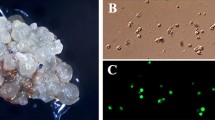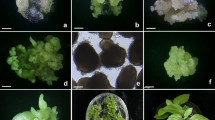Abstract
A protocol has been established for rapid, high frequency plant regeneration from protoplasts of the wild tomato species Lycopersicon chilense Dun. Cell suspension cultures were obtained from calli initiated from seedling stem explants. Protoplasts were isolated from cell suspensions by an overnight one-step enzyme digestion, purified by washing in salts solution and cultured in liquid medium. Dilution of liquid medium every 3 days, with medium containing low levels of growth regulators and sucrose, was critical for sustained colony formation. Up to 70% of protoplast-derived calli regenerated shoots when cultured on agar-solidified medium with Murashige & Skoog (1962) salts and vitamins, 2.0 mg l-1 zeatin and 0.1 mg l-1 indole acetic acid for 21 days, followed by transfer to the same medium lacking indole acetic acid.
Similar content being viewed by others
Abbreviations
- BAP:
-
6-benzylaminopurine
- IAA:
-
indole acetic acid
- IBA:
-
indole butyric acid
- MES-2:
-
(N-morpholino)-ethane sulfonic acid
- NAA:
-
α-naphthaleneacetic acid
- 2,4-d :
-
2,4-dichlorophenoxyacetic acid
References
Alexander LJ (1971) Host-pathogen dynamics of tobacco mosaic virus (TMV) on tomato. Phytopathol. 61: 611–617
Bonnema AB, Melze JM & O'Connell MA (1991) Tomato cybrids with mitochondrial DNA from Lycopersicon pennelii. Theor. Appl. Genet. 81: 339–543
Frearson EM, Power JB & Cocking EC (1973) The isolation and regeneration of Petunia leaf protoplasts. Dev. Biol. 33: 130–137
Galbraith DW (1989) Flow cytometric analysis and sorting of somatic hybrids and transformed protoplasts. In: Bajaj YPS (Ed) Biotechnology in Agriculture and Foresty 9. Plant Protoplasts and Genetic Engineering (pp 304–327). Springer-Verlag, Berlin, Heidelberg
Hammat N, Lister A, Blackhall NW, Gartland J, Ghose TG, Gilmour DM, Power JB, Davey MR & Cocking EC (1990) Selection of plant heterokaryons from diverse origin by flow cytometry. Protoplasma 154: 34–44
Holle M, Rick CM & Hunt DG (1978) Catalogue of collections of green-fruited Lycopersicon species and Solanum pennellii found in watersheds of Peru. Rep. Tom. Gen. Coop. 28: 50–78
Hoogenboom NG (1972) Breaking breeding barriers in Lycopersicon. 1. The genus and the importance of breaking these barriers. Euphytica 21: 221–227
Kinsara A, Patnaik SN, Cocking EC & Power JB (1986) Somatic hybrids plants of Lycopersicon esculentum Mill and Lycopersicon peruvianum Mill. J. Plant Physiol. 125: 225–234
Larkin PJ (1976) Purification and viability determinations of plant protoplasts. Planta 128: 213–216
Menczel L, Nagy F, Kiss ZR & Maliga P (1981) Streptomycin resistance and sensitive somatic hybrids of Nicotiana tabacum + Nicotiana knightiana. Correlation of resistance to N. tabacum plastids. Theor. Appl. Genet. 59: 191–195
Montagno TJ, Jourdan PS & Berry SZ (1991) Plant regeneration from leaf protoplasts of Lycopersicon hirsutum f. hirsutum. Plant Cell Rep. 9: 680–683
Morgan A & Cocking EC (1982) Plant regeneration from protoplasts of Lycopersicon esculentum Mill. Z. Pflanzenphysiol. 106: 97–104
Murashige T & Skoog F (1962) A revised medium for rapid growth and bioassays with tobacco tissue cultures. Physiol. Plant 15: 473–497
Nagata T & Takebe I (1970) Cell wall regeneration and cell division in isolated tobacco mesophyll protoplasts. Planta 92: 301–308
O'Connell MA & Hanson MR (1987) Regeneration of somatic hybrid plants formed between Lycopersicon esculentum and Lycopersicon pennellii. Theor. Appl. Genet. 75: 83–89
Power JB, Davey MR, McLellan M & Wilson D (1989) Laboratory Manual: Plant Tissue Culture, Plant Genetic Manipulation Group, University of Nottingham, Nottingham, UK
Ratushnyak YI, Latyov SA, Samoylov AM, Piven NM & Gleba YY (1991) Introgressive hybridization of tomatoes by ‘gamma-fusion’ of Lycopersicon esculentum Mill. and Lycopersicon peruvianum Dun. protoplasts. Plant Sci. 73: 65–78
Rick CM & Lamm R (1955) Biosystematic studies on the status of Lycopersicon chilense. Amer. J. Bot. 42: 663–675
San LH, Vadal F, Sihachakr D & Remy R (1990) Morphological and molecular characterization of fertile tetraploid somatic hybrids produced by protoplast electrofusion and PEG-mediated fusion between Lycopersicon esculentum Mill. and Lycopersicon peruvianum Mill. Mol. Gen. Genet. 221: 17–26
Shahin EA (1985) Totipotency of tomato protoplasts. Theor. Appl. Genet. 69: 235–240
Shillito RD, Paszkowski I, Müller M & Potrykus I (1983) Agarose plating and a bead type culture technique enable and stimulate development of protoplast-derived colonies in a number of plant species. Plant Cell Rep. 2: 224–247
Sotirova V & Rodeva R (1990) Sources of resistance in tomato to Septoria lycopersici Speg. Arch. Phytopathol. Pflanzenschutz. 5: 469–471
Stevens MA & Rick CM (1985) Genetics and Breeding. In: Atherton JG & Rudich J (Eds) The Tomato Crop (pp 35–109) Academic Press, New York
Tan MMC, Rietveld EM, vanMarrewijk GAM & Kool AJ (1987) Regeneration of leaf mesophyll protoplasts of tomato cultivars (L. esculentum): factors important for efficient protoplast cultures and plant regeneration. Plant Cell Rep. 6: 172–175
Uchimya H & Murashige T (1974) Evaluation of parameters in the isolation of viable protoplasts from cultured tobacco cells. Plant Physiol. 54: 936–944
Widholm JM (1972) The use of fluorescein diacetate and phenosafranin for determining viability of cultured plant cells. Stain. Tech. 47: 189–194
Wijbrandi J, vanCapelle W, Hanhart CJ, vanLoenen Martinet-Schuringa EP & Koorneef M (1990) Selection and characterization of somatic hybrids between Lycopersicon esculentum and Lycopersicon peruvianum. Plant Sci. 70: 197–208
Author information
Authors and Affiliations
Rights and permissions
About this article
Cite this article
Latif, M., Mumtaz, N., Davey, M.R. et al. Plant regeneration from protoplasts isolated from cell suspension cultures of the wild tomato, Lycopersicon chilense Dun.. Plant Cell Tiss Organ Cult 32, 311–317 (1993). https://doi.org/10.1007/BF00042294
Received:
Accepted:
Issue Date:
DOI: https://doi.org/10.1007/BF00042294




